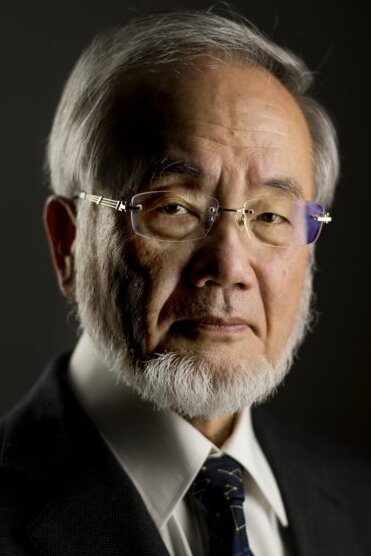2016 Nobel Prize for Autophagy Studies - Dr. Yoshinori Ohsumi

Autophagy – replacing old parts of the cell
The same process also happens at a sub-cellular level. You don’t necessarily need to replace the entire car. Sometimes, you just need to replace the battery, throw out the old one and get a new one. This also happens in the cells. Instead of killing off the entire cell (apoptosis), you only want to replace some cell parts. That is the process of autophagy, where sub-cellular organelles are destroyed and new ones are rebuilt to replace it. Old cell membranes, organelles and other cellular debris can be removed. This is done by sending it to the lysosome which is a specialized organelle containing enzymes to degrade proteins.Autophagy was first described in 1962 when researchers noted an increase in the number of lysosomes (the part of the cell that destroys stuff) in rat liver cells after infusing glucagon. The Nobel prize winning scientist Christian de Duve coined the term autophagy. Damaged sub cellular parts and unused proteins become marked for destruction and then sent to the lysosomes to finish the job.One of the key regulators of autophagy is the kinase called mammalian target of rapamycin (mTOR). When mTOR is activated, it suppresses autophagy, and when dormant, it promotes it.
What activates autophagy?
Nutrient deprivation is the key activator of autophagy. Remember that glucagon is kind of the opposite hormone to insulin. It’s like the game we played as kids – ‘opposite day’. If insulin goes up, glucagon goes down. If insulin goes down, glucagon goes up. As we eat, insulin goes up and glucagon goes down. When we don’t eat (fast) insulin goes down and glucagon goes up. This increase in glucagon stimulates the process of autophagy. In fact, fasting (raises glucagon) provides the greatest known boost to autophagy.Fasting is actually far more beneficial than just stimulating autophagy. It does two good things. By stimulating autophagy, we are clearing out all our old, junky proteins and cellular parts. At the same time, fasting also stimulates growth hormone, which tells our body to start producing some new snazzy parts for the body. We are really giving our bodies the complete renovation.You need to get rid of the old stuff before you can put in new stuff. Think about renovating your kitchen. If you have old 1970s style lime green cabinets sitting around, you need to junk them before putting in some new ones. So the process of destruction (removal) is just as important as the process of creation. If you simply tried to put in new cabinets without taking out the old ones, it wouldn’t look so hot. So fasting may in some ways reverse the aging process, by getting rid of old cellular junk and replacing it with new parts.
A highly controlled process
Autophagy is a highly regulated process. If it runs amok, out of control, this would be detrimental, so it must be carefully controlled. In mammalian cells, total depletion of amino acids is a strong signal for autophagy, but the role of individual amino acids is more variable. However, the plasma amino acid levels vary only a little. Amino acid signals and growth factor / insulin signals are thought to converge on the mTOR pathway – sometimes called the master regulator of nutrient signalling.So, during autophagy, old cell components are broken down into the component amino acids (the building block of proteins). What happens to these amino acids? In the early stages of starvation, amino acid levels start to increase. It is thought that these amino acids derived from autophagy are delivered to the liver for gluconeogenesis. They can also be broken down into glucose through the tricarboxylic acid (TCA) cycle. The third potential fate of amino acids is to be incorporated into new proteins.The consequences of accumulating old junky proteins all over the place can be seen in two main conditions – Alzheimer’s Disease (AD) and cancer. Alzheimer’s Disease involves the accumulation of abnormal protein – either amyloid beta or Tau protein which gums up the brain system. Although we don’t yet have clinical trial evidence for this, it would make sense that a process like autophagy that has the ability to clear out old protein could prevent the development of AD.What turns off autophagy? Eating. Glucose, insulin (or decreased glucagon) and proteins all turn off this self-cleaning process. And it doesn’t take much. Even a small amount of amino acid (leucine) could stop autophagy cold. So this process of autophagy is unique to fasting – something not found in simple caloric restriction or dieting.There is a balance here, of course. You get sick from too much autophagy as well as too little. Which gets us back to the natural cycle of life – feast and fast. Not constant dieting. This allows for cell growth during eating, and cellular cleansing during fasting – balance. Life is all about balance.—
- Jason Fung
Watch Rare Interview with Nobel Prize Winner, Dr. Yoshinori Ohsumi on Autophagy here.
Read Yoshinori Ohsumi: Autophagy From Beginning to End article here.
AMAZON AFFILIATE NOTICE: This website is an Amazon Affiliate and earns from qualifying purchases. A qualifying link can be identified by the (paid link) subscript to right of the link. Please note, this does not affect your cost in any way.